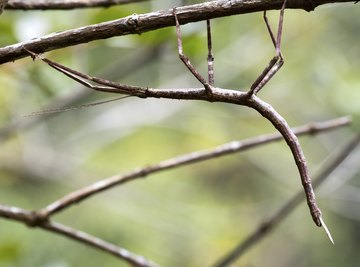
Walking stick bugs from the Phasmida family look like sticks with legs and antennae, or twigs attached to a small branch. There are more than 3,000 species of walking stick bugs all over the world and in diverse climates, so it's not surprising that not all walking stick bugs look alike. It depends on the trees in their native habitat: as walking stick bugs evolved to look like an indigenous twig or branch, and there are some other subtle — and less than subtle — variations between each subset of this insect.
TL;DR (Too Long; Didn't Read)
There are more than 3,000 species of walking stick bugs across the world, and each has evolved a camouflage and physiology distinct to their habitats. Though they all resemble twigs, there is a great deal of variation within this species: some reproduce asexually while others emit noxious odors to deter predators.
Big Sticks, Little Sticks
Walking sticks vary considerably in size according to their species. They average only a couple of inches in length, but the largest species, Phoebaetictus Kirby — native to Borneo — can reach an impressive 21 inches in length. In contrast, North America is home to the smallest species of walking stick, the Timema cristinea, which barely grows to a half inch long.
Eat and be Eaten
All walking sticks are herbivores. One of the reasons that they look like sticks is so they can graze on the leaves of their preferred trees in peace. They are an important food source for other animals — some of which eat them, while others eat their droppings, which come from their hardy digestive tract's ability to break down certain tough leaves. According to the San Diego Zoo, other insects prefer eating the droppings, while birds, bats, reptiles, spiders and small mammals enjoy a walking stick adult as a meal.
Hiding in Plain Sight
Walking stick bug body structure and coloration resemble real twigs or branches so strongly that often birds or other predators do not notice them at all. If this camouflage fails for whatever reason, some species of walking sticks have other means to protect themselves. Eurycantha horrida expels a very foul-smelling fluid. National Geographic reports that some species play dead, while others have grown small spines on their legs that inflict a painful blow. Some species are also able to fly.
Strange Mating Habits
Like all insects, walking stick bugs lay eggs to bring in new generations. A female of the species averages a few hundred eggs in her lifetime, which is up to three years in captivity. Although some species still use male-female mating to create fertilized eggs, many species are parthenogenetic with female-only populations — they reproduce without the involvement of males. Some species use both sexual and parthenogenetic means to make fertile eggs.
Caution Keeping Them in Captivity
Although walking stick bugs are available in the pet trade, there are laws in some areas that forbid owning these insects as pets. Also, National Geographic notes that it is unknown if harvesting walking sticks from the wild is causing an adverse effect on wild populations. John Locke of the University of Alberta warns that walking stick pets that escape into the wild can cause havoc in local environments.
References
About the Author
Rena Sherwood is a writer and Peter Gabriel fan who has lived in America and England. She has studied animals most of her life through direct observation and maintaining a personal library about pets. She has earned an associate degree in liberal arts from Delaware County Community College and a bachelor's degree in English from Millersville University.
